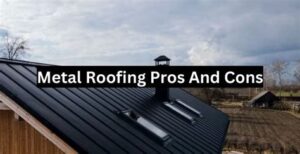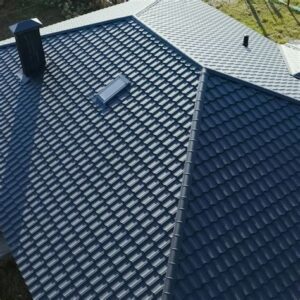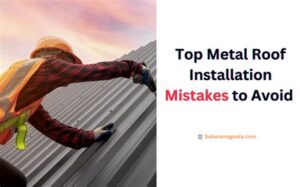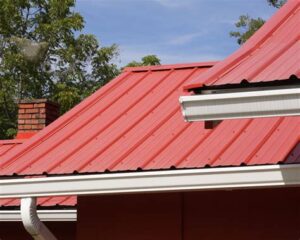When it comes to roofing options, the choice between metal and shingles can significantly impact your home’s energy efficiency and maintenance needs. As homeowners increasingly prioritize sustainability and cost-effectiveness, understanding the key differences between these two popular materials becomes crucial. This article delves into everything you need to know about metal versus shingles, providing insights into their energy efficiency benefits, maintenance requirements, and long-term cost analysis. We’ll explore how climate can affect your roofing decisions and help you weigh the advantages of each option. Whether you’re planning a new installation or considering an upgrade, our comprehensive guide will equip you with the knowledge to make informed roofing choices that benefit both your wallet and the environment. Read on to discover which roofing type is right for you!
Understanding The Basics Of Metal And Shingles Roofing
When considering roofing options, it’s essential to understand the fundamental differences between metal and shingles roofs. Each type has its characteristics, advantages, and disadvantages that can significantly affect long-term energy efficiency and maintenance requirements.
Metal roofing is known for its durability and longevity. Typically made from materials like steel, aluminum, or copper, metal roofs can last 40-70 years, significantly outlasting traditional roof coverings. They are lightweight, reduce the risk of fire, and offer fantastic aesthetic versatility. Furthermore, metal roofs reflect heat away from the home, contributing to lower cooling costs during hot months.
On the other hand, shingles are the most widely used roofing material, especially asphalt shingles. Designed to be a cost-effective and simple installation option, they typically last about 15-30 years. Shingles are available in various colors and styles, providing homeowners with flexibility in appearance. However, asphalt shingles absorb more heat than metal roofing, which can lead to increased energy consumption for air conditioning in warmer climates.
Both roofing types require different maintenance approaches and considerations, which will be addressed in the context of energy efficiency benefits and long-term costs. By understanding the basics of metal and shingles roofing, homeowners can make informed decisions regarding everything you need to consider for energy-efficient roof maintenance.
Everything You Need To Know About Energy Efficiency Benefits
When considering the energy efficiency of roofing materials, it’s essential to explore the various benefits associated with both metal and shingles roofing. Each type of roofing offers unique advantages that can significantly impact your energy consumption, overall comfort, and utility costs. Here’s a detailed look at the energy efficiency benefits of each roofing system.
Metal roofs are renowned for their reflective properties, allowing them to deflect sunlight rather than absorb it. This characteristic helps keep your home cooler, especially in warmer climates, and can lead to decreased air conditioning costs. Additionally, metal roofing systems are often coated with energy-efficient finishes that further enhance their reflective capabilities.
On the other hand, shingle roofs are typically made from materials that absorb heat, which can contribute to higher temperatures within the home. However, advancements in shingle technology have led to the introduction of cool roofing shingles that reflect more sunlight than traditional options. These newer materials can mitigate some of the heat absorption and lower energy costs.
Another significant energy efficiency aspect to consider is insulation. Regardless of whether you choose metal or shingles, proper insulation can enhance the energy efficiency of either roofing type. Insulation helps maintain indoor temperatures by minimizing heat transfer, ensuring that your heating and cooling systems work efficiently.
Moreover, the long lifespan of metal roofs can contribute to energy efficiency over time. With a lifespan of 40-70 years, metal roofs require less frequent replacements compared to asphalt shingles that generally last 15-30 years. This durability can lead to fewer materials being sent to landfills and a reduction in the energy required to manufacture new roofing materials, making them a more sustainable choice in the long run.
Both metal and shingles roofing options come with their own set of energy efficiency benefits. While metal roofing tends to have the edge in reflective properties and longevity, advancements in shingles are making them a more viable option for energy efficiency. As you consider your roofing material choices, think carefully about your local climate, energy needs, and the long-term benefits associated with each material—ensuring you choose the best option for your home.
Maintenance Requirements: Metal Roofs Vs Shingles
When it comes to roof maintenance, understanding the differences between metal roofs and shingles is crucial for homeowners. Each type offers distinct benefits and challenges that impact long-term upkeep.
Everything You need to know about the maintenance demands of these roofing options can help you make an informed choice for your home.
- Metal Roofs: One of the significant advantages of metal roofs is their durability. Typically, metal roofs require minimal maintenance compared to shingles. Regular inspections every few years are generally sufficient to identify any potential issues, such as rust or loose panels. Cleaning the roof to remove debris is the most frequent maintenance action needed to ensure optimal performance.
- Shingle Roofs: Shingle roofs, especially asphalt shingles, often require more attention and maintenance. Over time, shingles can curl, crack, or lose granules, leading to leaks if not addressed promptly. Homeowners may need to inspect their shingles more frequently, especially after severe weather events, and perform routine cleanings to prevent algae and moss buildup.
Additionally, hiring professionals for maintenance can vary in cost and frequency between the two types of roofing systems. This ongoing maintenance should also be factored into your overall cost analysis when considering energy-efficient roofing solutions.
Understanding the everything you need about maintenance for both metal roofs and shingles can significantly influence your decision-making process, ensuring that you choose the best option that suits your lifestyle and climate conditions.
Cost Analysis: Long-Term Savings From Energy Efficient Roofing
When evaluating the cost-effectiveness of roofing materials, it’s essential to consider not only the initial investment but also the long-term savings related to energy efficiency. Both metal and shingles roofs offer unique financial advantages, but their benefits can vary significantly based on numerous factors.
Everything You need to assess includes installation costs, maintenance expenses, and energy savings over time. Metal roofs typically have a higher upfront cost when compared to asphalt shingles; however, they can provide substantial savings in energy bills due to their reflective properties, which keep homes cooler during hot months.
On average, metal roofs may last 40-70 years, whereas asphalt shingles generally last around 20-30 years. This longevity can equate to fewer replacements, thereby reducing long-term costs. Additionally, many metal roofs come with warranties that extend beyond that of shingles, adding to their value proposition.
When analyzing energy savings, consider the following:
- Energy Efficiency: Metal roofs reflect solar radiant heat rather than absorbing it, leading to lower air conditioning costs in warmer climates.
- Insulation Impact: Utilizing proper insulation with roofing systems can further minimize energy usage, whether choosing metal or shingles.
- Tax Incentives: Some energy-efficient roofing materials may qualify for tax credits, enhancing their affordability over time.
While the initial investment in metal roofs may be higher than that of shingles, their potential for energy savings and longer lifespan can lead to significant cost advantages in the long run. Homeowners should carefully evaluate their local climate, energy costs, and personal preferences to determine the best roofing option that aligns with their financial goals.
Considering Climate Impact On Roof Maintenance Choices
When evaluating roofing materials, it’s essential to consider how climate impacts the choice between metal and shingles for maintenance and energy efficiency. The type of roofing you select can significantly influence not only your energy bills but also the longevity and upkeep of your roof. Here are key factors to take into account:
- Temperature Extremes: In regions with high temperatures, metal roofs reflect heat effectively, reducing cooling costs. Conversely, in colder climates, shingles can offer better insulation and warmth retention.
- Humidity and Moisture: Shingles may be more susceptible to moisture-related issues such as mold and mildew, especially in humid climates. Metal roofs, on the other hand, tend to resist moisture, making them a suitable choice for rainy areas.
- Wind Resistance: In areas prone to high winds, metal roofs excel due to their durability and installation methods. Shingles may tear or lift, necessitating more frequent repairs or replacements.
- Sun Exposure: Exposure to intense sunlight can degrade shingles over time, leading to a shorter lifespan. Metal roofs are typically more resilient, as they do not fade or warp as quickly.
By understanding everything you need to know about how climate influences roofing choices, homeowners can make informed decisions that will optimize maintenance needs and energy efficiency for years to come.
Frequently Asked Questions
What are the primary differences between metal and shingles roofing in terms of energy efficiency?
Metal roofs are generally more energy efficient than shingles, as they reflect solar radiant heat, which can reduce cooling costs by 10-25%. In contrast, shingles typically absorb heat.
How does the lifespan of metal roofs compare to shingles?
Metal roofs can last 40-70 years depending on the material, while asphalt shingles usually have a lifespan of 15-30 years. This longer lifespan can contribute to metal roofs being more energy efficient over time.
What are the maintenance requirements for metal roofs compared to shingles?
Metal roofs require less maintenance than shingles. While both types need regular inspections, metal roofs are less susceptible to issues like mold and algae, which can commonly affect shingles.
Is installation of metal roofing more complicated than shingles?
Yes, metal roofing installation can be more complex, often requiring professional installation to ensure proper sealing and insulation. Shingles, on the other hand, are typically easier to install.
What environmental benefits do metal roofs provide?
Metal roofs are often made from recycled materials and are recyclable at the end of their lifespan, making them an environmentally friendly choice. This can further enhance their energy efficiency profile.
Does the color of roofing materials affect energy efficiency?
Yes, lighter-colored roofing materials, including metal, tend to reflect more sunlight, improving energy efficiency. Shingles can also be found in lighter shades, but their heat absorption properties often make them less efficient overall.
How do local climate conditions impact the energy efficiency of roofing choices?
In hotter climates, metal roofs may provide superior energy efficiency due to their reflective properties, while shingles may create more heat absorption. Conversely, in cooler climates, shingles can provide better insulation.





